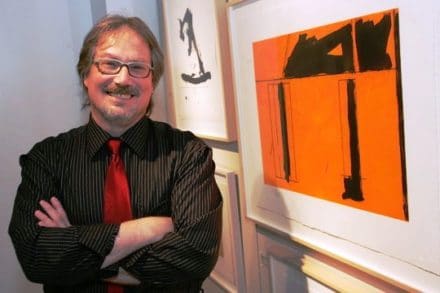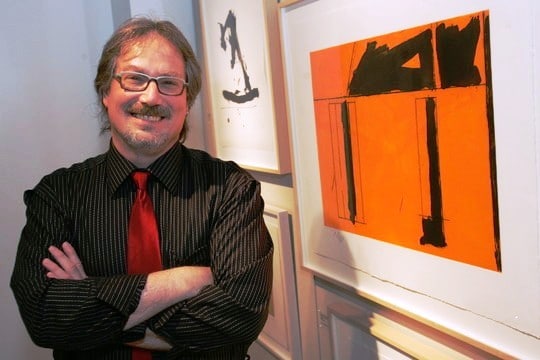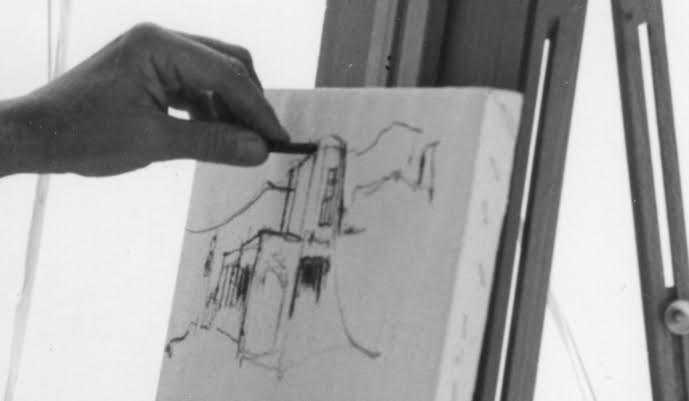 Frank Juliano is an exceptional storyteller. As Executive Director of Reeves-Reed Arboretum, his high standards for the garden, exhibited art, and educational programs aim to elevate how visitors experience nature. Frank spoke with CHF’s Editorial Coordinator, Jennifer Orbom, about effective curation, what actually creates positive change in the arts, and how some artists can do so well by their careers while others (unintentionally) wreak havoc.
Frank Juliano is an exceptional storyteller. As Executive Director of Reeves-Reed Arboretum, his high standards for the garden, exhibited art, and educational programs aim to elevate how visitors experience nature. Frank spoke with CHF’s Editorial Coordinator, Jennifer Orbom, about effective curation, what actually creates positive change in the arts, and how some artists can do so well by their careers while others (unintentionally) wreak havoc.
JO: You have a background in the arts. How did your interest in the environment develop?
FJ: I worked at Wave Hill, a public garden in the Bronx. It’s a 28-acre former estate, a remarkable, wondrous place. I was there for about eight years and loved it, but it’s a much more politically-charged climate there because of it’s location, and it’s role in the New York City hierarchy of museums and cultural institutions. I went on to do other things. I was the Executive Director of the Greenwich Arts Council, and in my last job I was headhunted for this job. It wasn’t that I had a particular interest or love of gardens. It’s just that I loved working at Wave Hill, so when this came up, I thought: ‘Well, this is like a smaller Wave Hill, so why not give it a try?’
“We’re introducing the public to the business of art, so it has to be art that stands alone.“
JO: In your Thriving Artist episode, you mention interviewing for your current job and being told by the Board that they weren’t enthusiastic about imposing an arts agenda. You countered with, “Then how do you fulfill your mission?”
FJ: It’s interesting, because they’ve fully embraced it now. They see that using arts as a portal to experience nature is very positive. We embraced the fact that our role is to engage people, and we have to explore all the ways we can do that while still conforming to our mission. The art I bring here has to tie in with our mission, which really frees me up a lot. Our current show is about how trees communicate, through their root systems. The artist came here and did castings, made three-dimensional clay pieces of the bark and the trees, so it’s the perfect combination of who we are as an arboretum and a nature organization: mixing the artistic element to explain something that is a universal, scientific fact.
“Artists spend so much time in the creative process—and we’re glad for that—but spend so little time understanding the business of art. As a result, they limit their abilities to really be stars in the marketplace.”
We’ve had significant growth. There are now over 101,000 visitors annually, up from 28,000 in 2009. That growth means significant responsibility, and one piece of that is to make the grounds fully accessible for all visitors. Everything we do, each step that the Arboretum makes, drives home the importance that what we’re trying to establish here is a legacy of service. We started a job-readiness initiative for the homeless—not specifically arts related, but because everything is holistic, I see it as connected.
JO: It’s refreshing to hear you talk about the overlap between art, nature, and the environment. What about the economic connection?
FJ: In a way, we’re building the business model for the artist, because we’re telling them, “When you do something here, you have to consider how it fits into the business model of Reeves-Reed Arboretum.” I insist on a certain quality for the art. It can’t just be art and nature for its own sake. I have our educators include the exhibits in their programming. They’re teaching students about stewardship of the environment through art, then we present it to the public who are coming in as customers of the Arboretum. We’re introducing the public to the business of art, so it has to be art that stands alone.
Our education programs have to equal the quality of the art. As a community organization, people will ask, “Why don’t you do a show with high school kids doing photography at Reeves-Reed Arboretum?” and as much as I understand the reasoning behind that, I’ve established a certain level of expectation and quality in terms of what we show and who we show, and I can’t go back. I ask the same of my educators. I ask the same of my horticulture staff. We always strive so that each level fulfills the business model, which is to be the absolute best as possible.
JO: You’re selling the art, so your standards for the artists are very high. You want to bring in art that people will buy.
FJ: Exactly. I think it’s my job, as a promoter and a curator, to fully understand and represent the art and artist. The artist needs to know that when they leave their art here, they can fully trust that I represent them in the most professional, businesslike way.
JO: How does selling high-ticket items work for a nonprofit?
FJ: We’re very lucky in that selling art is not our primary function. We have a little leeway in doing that, and this is something that organizations have to look at very carefully when they’re working with art. At the Greenwich Arts Council, our business was selling art as well as education, so that put us in a different tax category, with different responsibilities. Whereas, here, because that’s not my primary function, it’s easier to be able to sell art. The split favors the artist, they get 70% of the sale and the Arboretum’s 30% is a tax-deductible contribution from the artist, so they get a tax break.
The only thing the artist has to do is get their art to me. I don’t even ask them to be here for the install, because it’s my favorite part of the job. It’s like you’re putting a puzzle together. You sit there with all the art around you, and say, “Okay, what’s the story I want to say? When you walk in, where do I want your eyes to go, and where do I want them to travel throughout the exhibition?” It’s one of my favorite times, so I usually don’t even ask the artist to be around.
JO: One of my notes is “curator=storyteller.” The curator helps make art something that the public can understand and appreciate.
FJ: That’s so funny, because you see the opposite if you go to shows as often as I do. It’s glaringly opposite. You sit there and ask, “What were they thinking about?” It’s such a simple solution if you just take the time to see it as a story. Sometimes it’s a story in color, and your eyes want to follow a color palette. All it takes is a moment to really look at the art and live with it for a second or two, and then say, “Okay, this is how I’m going to hang it.”
JO: It sounds like curators provide guidance as well. Ideally, this would inspire the artist, provide a fresh perspective.
I think that’s the job of a good curator. I hope that the artists I work with feel that way. Sometimes, I find artists are very territorial, and frightened to let go of ownership. To get an artist to trust you is really the key, and the only way you can do that is to understand what your personal approach is and why you’re doing this show with this artist. The homework has to be done so far in advance that when they work with you, they are willing to commit and go for the ride, and learn something new about their art. Many times, they come in with preconceived notions, and when you start placing it, they get a little grouchy until you say, “Wait a minute, this is why. You’ll see it. When I finish the job, you’ll see why.” Trust is really important.
JO: So that’s something you see hold artists back: not letting others help with the business or with their promotion.
“She refused to budge, and as a result she didn’t sell a bloody piece. The show was enormously successful, but now it lives in her attic.”
FJ: I worked with a photojournalist who hadn’t had a show before, but her work was extraordinary. The photos were of women and children in Afghanistan during the first Taliban reign, and she took photographs through the mesh of the burka. I created a large show for her, the images were blown up six by nine feet, mounted; they were stunningly beautiful. When it came time to pricing, she said, “Well, this one has to sell for $10,000.” She’d never had an exhibition or sold a piece. I told her she had to start with a baseline people understood. Yes, her life had been in danger while making the pieces, but the buyer’s perspective is completely different from the creator’s. She refused to budge, and as a result, she didn’t sell a bloody piece. The show was enormously successful, but now it lives in her attic.
JO: And people probably wanted to buy, just not at those prices.
FJ: Oh, yes. As much as I admire her as an artist, I will never work with her again. To me, that says “you’re not listening, and you don’t trust me.” If you can’t trust me, why would I want to work with you? My job is to make you shine, and I can’t make you shine if you don’t allow me to.
JO: How do artists wise up?
FJ: The [Clark Hulings] Fund is really a godsend to artists, but not enough of them know about it. I start sending them links to it, and tell them to see what CHF offers. There needs to be more of that. There needs to be more education for artists. Artists spend so much time in the creative process, and we’re glad for that, but spend so little time understanding the business of art. As a result, they limit their abilities to really be stars in the marketplace.
JO: Have you seen any artists who have bloomed as business people? Who comes to mind?
FJ: There’s one person who I’ve worked with a lot, and he is a savvy business guy and entrepreneur: Tom Holmes, he’s a fantastic sculptor. He understands his product, and we can talk on this level, on art as product. On the very base level for this kind of discussion, art is a product, and he understands what he sells and how to market it. As a result, I’ve worked with Tom four or five times already.
“It was a negative reaction, but isn’t that better than being complacent?“
He’s had some really fabulous success, but he also had a big disaster with a contract in one community. He constructed the piece, and then people within the community hated the piece so much they vandalized the piece and destroyed it! He was heartbroken.
I said to him, “I know this is Pollyanna-ish, but what’s the goal of an artist?” The goal of an artist is to get a reaction. We assume the reaction we want is that the piece is fabulous, but in this case the reaction was, “This is a piece of crap. I hate it. Smash!” It might be painful, but he fulfilled his role as an artist. He created a piece, and stimulated so much emotion that people acted on that emotion. It was a negative reaction, but isn’t that better than being complacent?
JO: And public perception can change.
FJ: We’ve grown up with these stories. Look at Van Gogh or Seurat. Both struggled in their lifetimes, and were ignored. Seurat was so beaten down by the establishment, at that time, and now he’s viewed as a master.
JO: So is the establishment always a hindrance? Can public policy change the arts?
FJ: The best we can hope for is that public policy will occasionally give unexpected, unanticipated financial support to artists, but in terms of the quality of art, or generating creativity, I don’t think public policy can really do that. You’ll see it more in theater, in writing, even in music, but not so much in visual arts.
“That’s where change comes from. It doesn’t come from just giving money or opportunities. It comes from providing situations where growth can happen.“
I can see this on the city level of a nearby town, with the public arts commission. It’s made up of well-intentioned people, some of whom have some arts background, but because it goes through a “democratic” process, the ability to make decisions to identify and place public art is not good. Public art should define a community, but when you walk around some places, it looks more like a repository of art as opposed to an art exhibition. It looks like somebody said, “Okay, let’s take one of these, one of those, and I like this guy, and this guy’s my cousin’s brother-in-law,” and all of a sudden, you have 20 pieces on a village green that have nothing to do with one another. It’s linked to the concept we talked about before, about giving the audience a contiguous or a visual experience. Instead you walk away saying, “I have no interest.”
In order to have effective public policy, you have to have people with vested interest and experience. An insurance broker who covers public art for a city may want to develop a plan that would save the city money, but it has nothing whatsoever to do with serving the artist. The point of view of anything that’s official, from the city or the state, is not based on serving the artist, but based on a municipal need. A bureaucratic need. I don’t think change will ever truly come from there.
Change comes from these smaller instances where an organization is able to nurture artists and present the highest level of quality. Considering everything we’ve talked about today, if there’s that understanding, you’re going to exhibit art that has a point of view, with a component that teaches people why the show is there. That’s where change comes from. It doesn’t come from just giving money or opportunities. It comes from providing situations where growth can happen.






